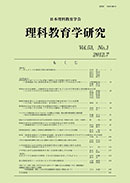Volume 63, Issue 2
Displaying 1-18 of 18 articles from this issue
- |<
- <
- 1
- >
- >|
Original Papers
-
2022 Volume 63 Issue 2 Pages 235-244
Published: November 30, 2022
Released on J-STAGE: November 30, 2022
Download PDF (1626K) -
2022 Volume 63 Issue 2 Pages 245-254
Published: November 30, 2022
Released on J-STAGE: November 30, 2022
Download PDF (758K) -
2022 Volume 63 Issue 2 Pages 255-266
Published: November 30, 2022
Released on J-STAGE: November 30, 2022
Download PDF (1454K) -
2022 Volume 63 Issue 2 Pages 267-280
Published: November 30, 2022
Released on J-STAGE: November 30, 2022
Download PDF (1080K) -
2022 Volume 63 Issue 2 Pages 281-297
Published: November 30, 2022
Released on J-STAGE: November 30, 2022
Download PDF (868K) -
2022 Volume 63 Issue 2 Pages 299-310
Published: November 30, 2022
Released on J-STAGE: November 30, 2022
Download PDF (1255K) -
2022 Volume 63 Issue 2 Pages 311-322
Published: November 30, 2022
Released on J-STAGE: November 30, 2022
Download PDF (877K) -
2022 Volume 63 Issue 2 Pages 323-331
Published: November 30, 2022
Released on J-STAGE: November 30, 2022
Download PDF (1998K) -
2022 Volume 63 Issue 2 Pages 333-344
Published: November 30, 2022
Released on J-STAGE: November 30, 2022
Download PDF (4419K) -
2022 Volume 63 Issue 2 Pages 345-355
Published: November 30, 2022
Released on J-STAGE: November 30, 2022
Download PDF (809K) -
2022 Volume 63 Issue 2 Pages 357-371
Published: November 30, 2022
Released on J-STAGE: November 30, 2022
Download PDF (2153K) -
2022 Volume 63 Issue 2 Pages 373-380
Published: November 30, 2022
Released on J-STAGE: November 30, 2022
Download PDF (911K) -
2022 Volume 63 Issue 2 Pages 381-398
Published: November 30, 2022
Released on J-STAGE: November 30, 2022
Download PDF (849K) -
2022 Volume 63 Issue 2 Pages 399-414
Published: November 30, 2022
Released on J-STAGE: November 30, 2022
Download PDF (1025K)
Notes
-
2022 Volume 63 Issue 2 Pages 415-423
Published: November 30, 2022
Released on J-STAGE: November 30, 2022
Download PDF (1365K) -
2022 Volume 63 Issue 2 Pages 425-435
Published: November 30, 2022
Released on J-STAGE: November 30, 2022
Download PDF (2506K) -
2022 Volume 63 Issue 2 Pages 437-444
Published: November 30, 2022
Released on J-STAGE: November 30, 2022
Download PDF (1226K) -
2022 Volume 63 Issue 2 Pages 445-453
Published: November 30, 2022
Released on J-STAGE: November 30, 2022
Download PDF (1240K)
- |<
- <
- 1
- >
- >|
